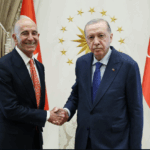[Summary by Geopolist | Istanbul Center for Geopolitics:
- Once the wealthiest colony in the Americas, Haiti is now the poorest country in the Western Hemisphere, with more than half of its population living below the poverty line.
- Foreign intervention, debt, political instability, and natural disasters have long hindered development efforts in Haiti. However, there is hope that a new prime minister could help stabilise governance.
- While the Joe Biden administration has ruled out sending U.S. troops to the island, they have pledged to provide financial support for a UN-authorised, Kenya-led multinational force to fight Haiti’s powerful gangs.
Haiti’s Troubled Path to Development
Introduction
Few countries have struggled with development like Haiti. Since breaking free from French colonial rule over two centuries ago, the Caribbean state has weathered multiple foreign interventions, chronic political instability, social unrest, and devastating natural disasters. The confluence of these forces has transformed what was once the wealthiest colony in the Americas into the poorest country in the Western Hemisphere.
The United States has had a long and troubled history with Haiti, including a nearly twenty-year, sometimes bloody, occupation in the early twentieth century. Despite an often rocky relationship, the two countries maintain close economic and social ties, although bilateral relations have come under increased strain in recent years. During his tenure, President Donald Trump sought to restrict immigration from Haiti, sending thousands of Haitians back on deportation flights. Though President Joe Biden promised a new approach toward the country, he has continued to deport Haitian asylum seekers en masse even as the situation on the island grows increasingly dangerous, challenging U.S. policy on multiple fronts.
What are Haiti’s origins?
Spanish settlers arrived on the island of Hispaniola, which comprises modern-day Haiti and the Dominican Republic, in 1492. Within a quarter-century, diseases brought by Europeans, such as smallpox and measles, decimated the Indigenous Taíno population. Over the next three centuries, European colonizers imported hundreds of thousands of enslaved people from western and central Africa to harvest sugar, coffee, and timber—all lucrative exports.
In the early 1600s, French traders established an outpost on the western third of the island, which Paris annexed as the colony of Saint-Domingue several decades later. In the late 1700s, Toussaint L’Ouverture and Jean-Jacques Dessalines, both formerly enslaved, led a rebellion against French rule that culminated with the creation of Haiti in 1804. The first postcolonial Black republic, Haiti became a beacon of abolition, self-determination, and racial equality.
What is Haiti’s economic situation?
Haiti is the poorest country in the Western Hemisphere. More than half the population lives below the poverty line, with limited access to basic services, and many people rely on subsistence farming to feed their families. The country is also heavily dependent on external revenue: between 2010 and 2020, the United Nations allocated more than $13 billion in international aid for Haiti, most of which has funded disaster-relief missions and development programs. Meanwhile, Haitian remittances have steadily risen over the past two decades, totaling $4.3 billion in 2023 as the island remains paralyzed by multiple crises.
Since 2010, trade has composed 41 percent of Haiti’s GDP on average. The country’s major industries include sugar refining, flour milling, and cement and textile manufacturing; textiles accounted for $1.15 billion, making up 85 percent of all exports in 2021. The United States is Haiti’s largest trade partner, followed by Canada and Mexico.
In recent years, natural disasters, disease, political instability, mismanagement of humanitarian relief, and a depreciation of the gourde—Haiti’s currency—have strained the economy. Tourism, once a vibrant sector, has declined. Compared to a record 1.3 million tourists in 2018, which drew in $620 million, Haiti welcomed only 148,000 travelers in 2021, generating around $80 million in profits. That same year, the neighboring Dominican Republic welcomed five million tourists.
Haiti remains heavily in debt. For example, while international lenders canceled Haiti’s debt following a massive earthquake in 2010, since then its total public debt has since risen mostly due to disbursements related to PetroCaribe—the Venezuela-led regional alliance that offers its members subsidized oil. At the end of fiscal year 2021 (FY 2021), Haiti’s public debt totaled $5 billion, or nearly 30 percent of its GDP. Further upheaval, including an escalating protest movement, the 2021 assassination of President Jovenel Moïse, back-to-back natural disasters in July and August 2021, and rampant gang violence have placed further stress on the country’s economic situation.
Why has Haiti had such difficulty developing?
Since its independence from France, Haiti’s development has been menaced by forces that run the gamut, including interference of foreign powers, domestic political malfeasance, natural disasters, social instability, and epidemics.
Foreign intervention and debt. Freedom from France in 1804 did not mean an end to foreign powers intervening in Haiti. France only recognized an independent Haiti in 1825 after its former colony agreed to pay reparations that are estimated to be worth $21 billion in today’s dollars. Over the next 122 years, as much as 80 percent of Haiti’s revenues went to paying off this debt.
The United States recognized Haiti only in 1862, when President Abraham Lincoln was championing emancipation at home and abroad. Subsequent U.S. administrations viewed Haiti through a mostly strategic lens. Wary of encroaching German influence in the Caribbean at the outset of World War I, President Woodrow Wilson ordered Marines to Haiti in 1915, purportedly to restore political stability. In the five years prior, seven Haitian presidents were ousted from office or assassinated. During the nearly two-decade occupation, the United States controlled Haiti’s security and finances; it also imposed racial segregation, forced labor, and press censorship, and deposed presidents and legislatures that opposed the U.S. presence. Some fifteen thousand Haitians were killed in rebellions against the U.S. administration, the bloodiest of which occurred in 1919 and 1929. President Franklin D. Roosevelt withdrew U.S. troops in 1934 as part of his Good Neighbor Policy.
Political instability. The U.S. withdrawal was followed by a series of unstable governments, which culminated in 1957 with the establishment of a dictatorship under François Duvalier and his son, Jean-Claude. Their twenty-nine-year rule was characterized by corruption that drained the nation’s coffers and human rights violations that left an estimated thirty thousand people dead or missing. In 1986, massive protests and international pressure forced the younger Duvalier to flee the country, giving way to a new constitution and democratic institutions [PDF].
However, political instability persisted. Jean-Bertrand Aristide, the country’s first democratically elected president, was twice deposed in coups, in 1991 and 2004. Both prompted U.S. military interventions supported by the United Nations. In 2004, the United Nations launched a thirteen-year peacekeeping mission, the Brazil-led UN Stabilization Mission in Haiti (MINUSTAH) [PDF], which sought to restore order after the fall of the Aristide government. In 2011, the election of Michel Martelly as president was clouded by allegations of U.S. meddling on his behalf. He later stepped down after postponing presidential elections twice and ruling by decree for more than a year. Haiti was cast into a political vacuum in 2016, when fraud allegations against Martelly’s successor, Jovenel Moïse, postponed Moïse’s official election until early 2017.
Moïse’s presidency saw mass protests and calls for his resignation in response to increased fuel prices and the removal of government subsidies, accusations of corruption, a worsening economic crisis, and dispute over his administration’s legitimacy. The widespread social unrest culminated in Moïse’s July 2021 assassination. U.S. authorities initially arrested several mercenaries, many of whom had received U.S. military training, on suspicion of involvement in the killing. Eleven people now face charges in a U.S. court in connection to the murder, even as Haiti’s own investigation has proceeded slowly; in February 2024, a Haitian judge charged Moïse’s widow with complicity in his killing.
Ariel Henry, named prime minister only days before the murder, took over as acting president and came under suspicion after Haiti’s chief prosecutor alleged that Henry was in communication with a key suspect. In January 2022, Henry survived an assassination attempt himself. After postponing it several times, the government has committed to holding a general election by August 2025. With gang violence on the island worsening, Haiti and Kenya reached a deal in March 2024 authorizing the deployment of one thousand Kenyan police officers to Haiti as part of a UN-backed multinational stabilization mission, beginning with a contingent of a few hundred officers. In May, a transitional council, created to help form a new government in the wake of Henry’s resignation, chose Garry Conille as Haiti’s new prime minister. Conille briefly served in the role between 2011 and 2012.
A massive earthquake near the capital in 2010, for example, killed about 220,000 Haitians and displaced 1.5 million more. At $8 billion, basic reconstruction costs surpassed the country’s annual GDP. Between 2015 and 2017, drought led to crop losses of 70 percent, and in 2016, Hurricane Matthew decimated the country’s housing, livestock, and infrastructure. Haiti was then struck by back-to-back disasters in August 2021, when a magnitude 7.2 earthquake rocked the southern peninsula, destroying 30 percent of local homes, killing over 2,000 people, and displacing tens of thousands more. Days later, Tropical Storm Grace exacerbated the destruction, dumping heavy rains and triggering flash flooding and landslides. Inclement and dangerous weather has continued to strike the island as the threat of climate change intensifies.
A number of factors magnify the impact of such disasters, including poor urban planning; substandard infrastructure and housing; large coastal populations; and widespread dependence on subsistence farming, which can degrade the environment if overexploited.
Epidemics and aid mismanagement have further complicated matters. Dengue and malaria run rampant, and cholera, introduced by UN peacekeepers from Nepal after the 2010 earthquake, has killed almost ten thousand people and infected nearly one million more. Despite declaring itself cholera-free in 2022, a lack of access to healthcare and other essential services is fueling a resurgence of the disease across the island. At the same time, billions of dollars in aid pledges from governments and organizations following the 2010 crisis are still unaccounted for.
How have recent U.S. administrations approached Haiti?
Washington’s stated aims have been to bring political and economic stability to its southern neighbor while easing Haiti’s humanitarian distress. The Barack Obama administration focused on strengthening Haiti’s national police force, boosting economic security, improving health and education services, and buttressing infrastructure. Under Obama, the United States led the international responses to Haiti’s crises, calling the country a “key foreign assistance priority” [PDF] in the Caribbean, and continued to support the United Nations’ MINUSTAH mission. Since the 2010 earthquake, the U.S. Agency for International Development (USAID) has been Haiti’s top donor, contributing more than $5 billion, including millions in support of disaster-risk reduction programs.
On trade, a series of accords struck by President George W. Bush and extended under Obama provide Haitian textiles with duty-free access to the United States. As of 2020, more than 83 percent of all Haitian exports were going to the United States.
Immigration has been a central issue in the U.S.-Haiti relationship. Between 1990 and 2015, the Haitian immigrant population in the United States tripled as Haitians fled political instability and natural disasters, though some previous U.S. administrations responded with harsh detention and repatriation policies. After the 2010 earthquake, Obama granted Haitians temporary protected status (TPS), which affords undocumented migrants from troubled countries the right to live and work in the United States for renewable periods of up to eighteen months. According to the latest American Community Survey, more than one million people of full or partial Haitian descent resided in the United States in 2021, making the country home to the largest Haitian population outside of Haiti.
What did Trump do?
The Trump administration cut USAID’s humanitarian and development assistance to Haiti by nearly 18 percent in 2017 as part of broader reductions to U.S. foreign aid, but preserved funding for initiatives to reduce poverty, improve infrastructure and services, and promote democratic institutions. Several trade agreements from the Obama era have likewise endured, including Haiti’s duty-free access to U.S. markets, which was among the deals renewed by the Trump administration. When protests erupted across Haiti in 2019, Trump supported President Moïse, who faced accusations of political illegitimacy and growing authoritarianism.
At the same time, Trump diverged from his recent predecessors on immigration, particularly with regard to TPS, which he sought to end for many countries. In late 2017, he denied some 59,000 Haitians an extension of their protected status, leading to the deportation of more than 2,500 [PDF] of them between 2018 and 2020. However, Haiti’s TPS designation was subsequently extended several times due to legal rulings against the Trump administration’s policies, as well as Haiti’s ongoing instability.
What is Biden’s approach?
Before taking office, President Biden promised a new era of U.S. engagement with Latin America and the Caribbean. However, his response to Haiti’s ongoing crises has drawn ire from locals who say the United States has done little to help and spurred calls for stronger action.
In January 2021, the administration announced that it was sending $75.5 million in development aid and health assistance to Haiti. Following the August earthquake, the administration approved an additional $32 million in disaster-relief funds and authorized USAID rescue teams to be dispatched to the island. In response to the country’s deteriorating political and security situation, the Biden administration revived TPS for an estimated 155,000 Haitians, announcing a new, eighteen-month designation [PDF] in May 2021. (Haiti was again redesignated for TPS beginning in February 2023.)
The administration also contributed another $50 million to Haiti’s recovery fund alongside other UN members during an international aid conference led by the United Nations in February 2022. The United States later designated Haiti a priority country under the 2022 Global Fragility Act, which aims to provide funding to prevent and reduce violent conflict and promote stability in five at-risk countries and regions. In March 2023, as part of the Act’s implementation process, the White House announced a ten-year strategic plan aimed at fostering stability in Haiti.
Though he lifted Title 42, Biden has maintained some aspects of Trump’s border policy. Fearing a migration surge after Title 42 expired in May 2023, the Biden administration unveiled a restrictive new policy that allows the government to deny asylum to migrants who did not previously apply for it in a third country and to those who cross the border illegally. Among those affected by the policy are thousands of Haitian asylum seekers; since Biden took office, more than twenty-seven thousand [PDF] asylum seekers have been deported back to Haiti. To incentivize legal migration, meanwhile, the administration created new humanitarian parole programs for nationals of four Latin American countries, including Haiti.
Some policy analysts have argued that the Biden administration’s response in the aftermath of President Moïse’s murder was lackluster. Several members of Congress urged Biden to withdraw his support for Prime Minister Henry, arguing that he lacked the political sway needed to organize elections to determine Haiti’s next president. Others in Congress pressed the administration to halt mass deportations of Haitians under Title 42—a practice that drove the U.S. special envoy to Haiti to resign in October 2021.
Meanwhile, the White House continues to rule out sending U.S. troops or additional military assistance to Haiti. However, the United States remains the largest humanitarian donor to Haiti, and USAID has provided the island with more than $146 million in emergency assistance since FY 2023. Washington has also pledged to financially back the deployment of the Kenya-led multinational force to help local police fight Haiti’s gangs. As the security situation in Haiti rapidly deteriorates, the Biden administration has urged all U.S. citizens on the island to leave, even as deportation flights continue.
Source: Council on Foreign Relations (CFR)







